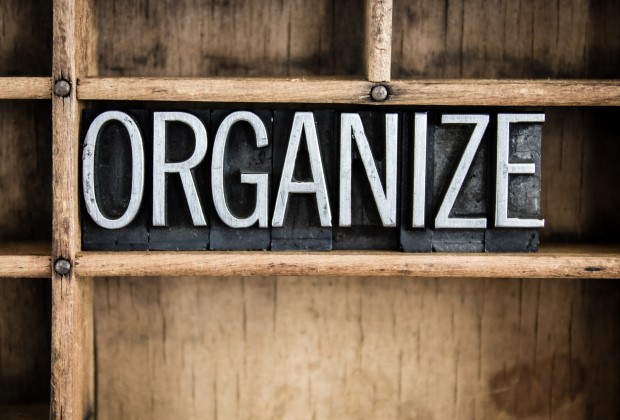
We sat on the bed’s edge in what Jennifer called “her dump-it room.”
This spot, previously occupied by her daughter, now served as a dumping ground for stuff she didn’t know what to do with. Like two brave archeologists, we made it through the layer of newer items. The next layer showed evidence of previous attempts to get organized: sorted piles abandoned like mummified remains from Pompeii.
Jennifer let out a deep sigh.
“Story of my life,” she told me. “I never got it done. When I did, it was only a matter of time before the mess came back.”
She was silent for a moment. “My mother always told me what a slob I was. Then my ex- took over. Now my daughter gets on my case because she has nowhere to stay when she visits. I’m such an embarrassment!”
Just then, my eyes landed on a plaque that said, “Indecision may or may not be my problem.”
I held it up to show her. We burst out in laughter mixed with tears.
Humor shines light on truth.
I’ve seen many similar signs in my organizing career.
A common one is “Bless this Mess!” Or: “Please excuse the mess: the kids are busy making memories.” Another version says the quiet part out loud: “Please excuse the mess: I suck at being a housewife.”
My theory is that these plaques signify something profound: traditional organizing methods leave no middle ground between neatness and chaos.
And so, humor elbows its way into the moralistic, either/or definition of organized.
Humor declares the truth that we’re missing a legitimate model for “organized enough.”
The focus of organizing is all wrong.
Too often, organizing focuses on making a space look a certain way.
With this product, your problems will disappear! Apply your willpower and XYZ Magical Method to have your dream home!
The picture-perfect end result makes no mention of what it takes to get there or maintain it.
Color-coded books in a toddler’s room and pantry shelves lined with glass containers are beautiful.
But at what price?
Did they explain how you’ll spend precious minutes each day re-shelving books by color? What happens when the toddler swipes them all onto the floor?
With the fancy pantry, you’ll trudge to the store for groceries, bring them in and unpack, and also: remove them from their packaging, pour them into the pretty jars, cut out the cooking instructions, relabel the expiration date on the jar, and find a spot for the contents that don’t fit in the lovely container.
Whew! Let me offer a simpler goal: to be organized means finding what you need, when you need it.
Function is essential. Pretty is a bonus.
Customized expectations, curiosity, and self-compassion: a winning trio.
For more than 16 years as a Certified Professional Organizer in Chronic Disorganization and a Certified Productivity Coach, I’ve witnessed women berate themselves for not being perfectly organized.
Instead of setting expectations that support their life situation, they try to prove themselves worthy of the gold star of traditional organizing with overly-complex systems, decluttering marathons, trying to go it alone, failing, then assuming the blame.
Can we please shift the narrative away from believing you’re a fixer-upper?
Here are three steps to break this unhelpful pattern.
1.Develop curiosity about your situation.
What else might be contributing to how the space functions? Perhaps you’re setting your mail in multiple spots, causing bill payment to be late. A curious observer notices where the mail most frequently lands, then builds an action file system at that location.
Are you dealing with depression, anxiety, or AD/HD? Do you have a traumatic brain injury? Do you suffer from a chronic condition, limiting your energy levels? Are you a caregiver for young kids or a loved one?
These brain-based, physical, and situational factors will impact how you approach things, whether you fully acknowledge it or not.
Act as though you’re an anthropologist who is simply observing the elements of an environment – without judgment attached.
2.Customize expectations of yourself based on your situation.
If your vision needs correction, you don’t just squint harder. You get eyeglasses.
The same goes for ADHD. When laundry doesn’t follow the traditional sequence of washing, drying, folding, and putting it away in a drawer or closet, then simplify the process. Reduce steps as much as possible. Think outside the box (or drawer). Design your clothing storage system to use wall hooks or open baskets for different categories. Only hang what needs to look presentable.
Caregivers, whose days consist of responding to others’ needs, get to bring in help to lighten their load. Housecleaners, grocery delivery, or respite care not only take care of necessary tasks, but the act of asking for assistance asserts that you’re allowed to make space for your own needs.
Can you see how this process involves so much more than decluttering stuff?
You are creating a life that serves you.
3.Practice radical self-compassion.
Women are conditioned to be “good helpers” who put aside their desires and take up minimal space and time.
We are taught that over-giving marks the noblest path. In reality, this approach blocks the natural flow of the universe. It’s an illusion to think you can only give to others.
So don’t call yourself a giver if you cannot give to yourself.
The cycle of giving and receiving keeps your life force in balance. When you find peace with giving and receiving, decision-making improves.
Did you know that objects have life cycles?
Again, this demonstrates the natural flow of energy. You receive, then release so that you might receive something else. Don’t block your well-being by clinging to items that can be released with gratitude.
Practicing radical self-compassion means feeling whatever arises and accepting the truth your situation presents.
The middle way brings ease and a sense of abundance.
The question isn’t: “What’s the right way to organize?” It’s: “What’s the right way for me to organize?”
Organizing helps you practice important skills: self-acceptance, honoring your needs, asking for and receiving help. Plus, you’ll enjoy the tangible results of an organized space.
From our work together, Jennifer learned how to be curious about herself, build easier organizing systems, and practice self-compassion. Plus, she got better at decisions, which meant she could get rid of the indecision sign. Jennifer opened up physical space. More importantly, she made space to honor her wholeness. Find your own middle way. Do the soul work through the physical work, and experience the frequency of flow.


